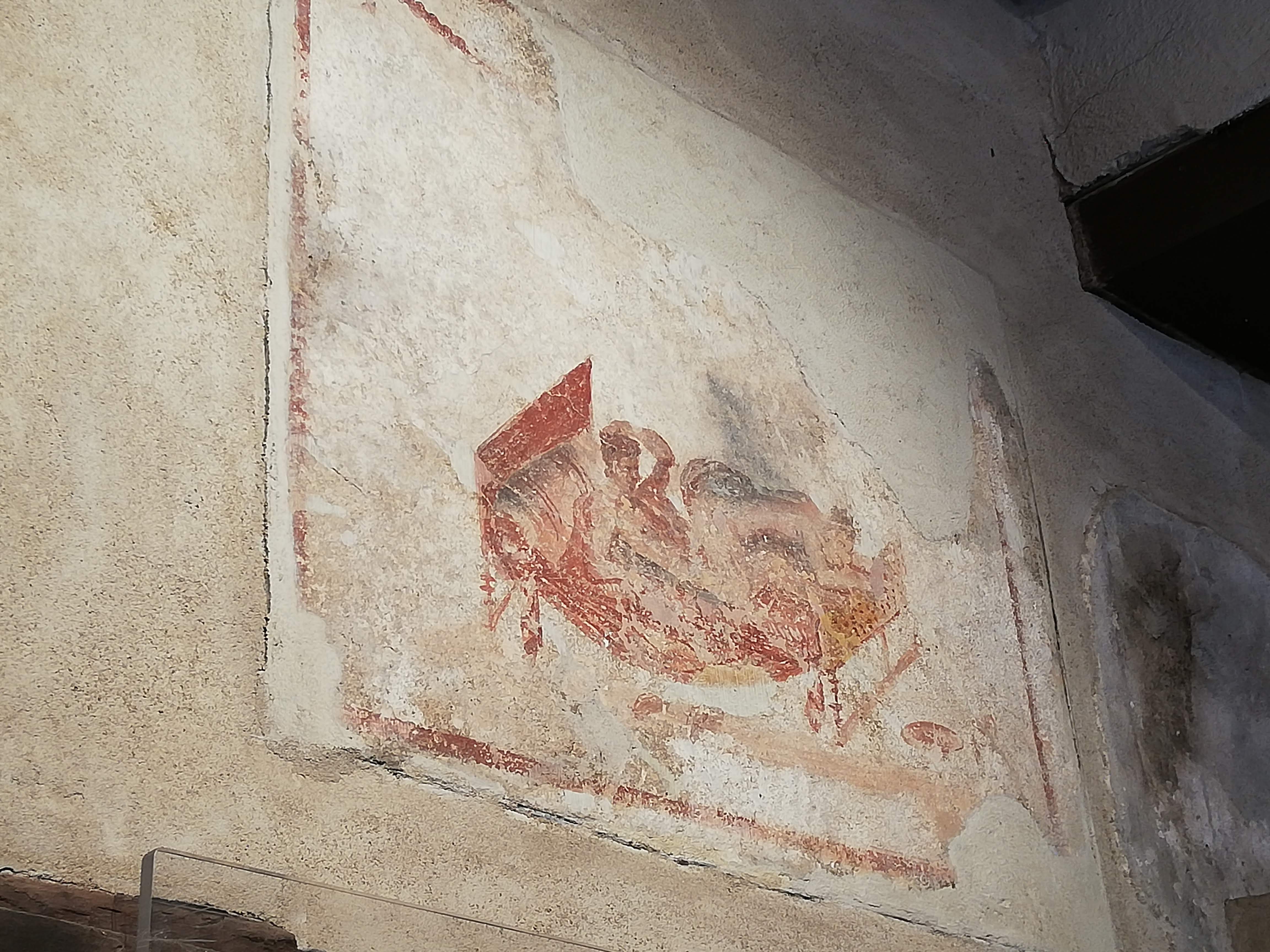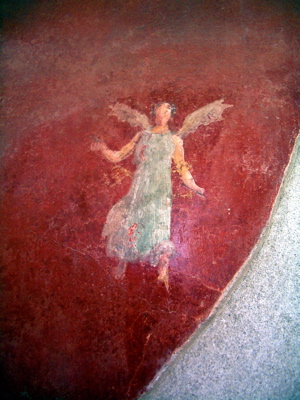Pompeii Fresco Paintings
- A Quick Intro Into Pompeii Art
"Pompeii fresco paintings of Villa of the Mysteries and other Pompeii homes have been wonderfully preserved after the big Vesuvius volcano eruption..."
Where can you see Pompeii fresco paintings?
Walking down the streets of Pompeii, and looking at the grandiose public buildings like the amphitheater, Pompeii baths, temples and buildings in the Pompeii Forum is a real experience in itself.
But as you start entering into and exploring Pompeii homes you will be rewarded with a more intimate kind of Pompeii art… Pompeii fresco paintings.
Some of the best places to see Pompeii fresco paintings are:
- Villa of the Mysteries: This villa is known for its elaborate and enigmatic frescoes that depict a mysterious initiation rite. It's one of the most famous locations for frescoes in Pompeii.
- House of the Vettii: This house is adorned with stunning frescoes that showcase various scenes, including mythological figures and intricate architectural details.
- House of the Faun: This is one of the largest and most lavish houses in Pompeii, featuring a central courtyard surrounded by frescoes. The Alexander Mosaic, one of the most famous ancient Roman mosaics, was found here but can now be seen in the National Archaeological Museum in Naples.
- House of the Tragic Poet: This house contains frescoes that are believed to depict scenes from Greek tragedies, hence its name.
- House of the Lovers (Casa degli Amanti): This house is famous for its poignant fresco of two lovers, suggesting a tragic story.
- Villa of the Papyri: Although part of the villa remains unexcavated, it is known for its library and collection of papyrus scrolls. The villa also had extensive frescoes.
- House of the Ancient Hunt (Casa dell'Ancora): This house is adorned with frescoes depicting scenes of hunting and outdoor life.
- House of the Surgeon (Casa del Chirurgo): Named after the tools found there, this house contains well-preserved frescoes that provide insight into ancient surgical practices.
- The Lupanar: This ancient brothel in Pompeii contains some rather explicit frescoes that provide a glimpse into the daily life and sensibilities of the time.
- The Forum Baths: These public baths feature frescoes on the walls, offering a look into Roman bathing practices and decor.
So much to see but not sure how to get to Pompeii?
Here's some shore excursions with good reviews:
What technique was used for Pompeii fresco paintings?
Frescoes in Pompeii were painted in the bouon fresco technique, which consisted of painting in pigment mixed with water on a thin layer of wet, fresh lime mortar or plaster.
The pigment is absorbed by the wet plaster, when the plaster dries and reacts with air, it fixes the pigment particles in the plaster. When the actual painting was finished, a fine layer of wax was passed over the work.
Why are Pompeii frescos so well preserved?
It’s the infamous Vesuvius volcano, the same one that killed thousands of people, we can thank for the fact we can actually enjoy these today. An ironic testimony to the fragility of human life and the endurance of art, isn’t it?
Although at first it seemed that one of the biggest natural disasters in the history of humankind actually destroyed all Pompeii art, it actually preserved it for posterity and provided modern art historians precious information on the ancient painting and decoration.
Having been buried under layers of volcanic ash for 1500 years, the colours of Pompeii fresco paintings are still unbelievably vibrant today… can you imagine what they were like the day they were created?
One of the colors that strikes us with its vibrancy most is a certain hue of red… Pompeii’s signature color, now called Pompeii red.
Pompeii homes of those times were very sparse with furnishings.
Rooms were quite small and claustrophobic… so they used Pompeii fresco paintings to widen their horizons.
They were also quite dark and windowless… so they used Pompeii frescoes to brighten them. They used frescoes as we would today use paint, wallpaper, or artwork.
Would you like to know even more about the art and architecture of Pompeii? Visit with an archeologist by your side:
For us today, Pompeii fresco paintings are a great window into the everyday life of the lost city of Pompeii: we can learn that people of the ancient city Pompeii were very open about their sexuality… it was very normal to live side by side with erotic frescoes as if they were landscapes of still life.
Next, we learn they treated religious and mythological themes with a very earthly approach: ancient gods and goddesses were something that decorated their houses.
Other favorite themes of Pompeii fresco paintings were country scenes, magnificent landscapes, views of the sea and blue skies, architecture, fruit trees and lush vegetation, still life…
The most intriguing example of Pompeii fresco art still today is the frescoes that adorn the famous Villa of the Mysteries’ Initiation Chamber. Still to this day art historians can not agree on the interpretation. To learn more about what their meaning might be read our article Villa of the Mysteries.
Visiting Pompeii with kids? There are some great tours that both parents and kids will enjoy:
What are the styles of Pompeii fresco art?
Pompeii art can be classified into four styles:
1. THE FIRST STYLE: Incrustation style, popular from 150 BC to 80 BC and can be recognized by faux finishes simulating marble. This style emulates the Ptolemaic palaces of the Near East where real marble was used. It reflects the spread of Hellenistic culture.
2. THE SECOND STYLE: Architectural style, popular between 80 BC and 14 AD. Uses tromp l’oeil technique - flat images that with the clever use of perspective, trick the eye into thinking it’s seeing a dimensional object. That way, the claustrophobic walls of the room gave an illusion of being open into the outside world, looking into imaginary scenes.
3. THE THIRD STYLE: Ornamental style, used up to the year 62 AD, which was the year of the big earthquake in Pompeii. This style loses the use of space and architectural features; the space doesn’t open up towards the outside but rather creates the “ picture gallery” effect. Landscapes are shown inside miniature frames inserted into a single color background. This style is also known for the presence of typically Egyptian elements: lotus flowers, rosettes, small stars…
4. THE FOURTH STYLE: or the Illusionist style of Pompeii fresco art, used from 62 AD to 79 AD, the year of the big Vesuvius volcano eruption. This style is a baroque combination of all of the above styles.
A lot of Pompeii fresco art has been removed from the site since the first big archaeological digs in the 18th Ct to be protected from looters and the elements.
That’s why many of them can be seen in the Archaeological Museum of Naples.
Some of those still available for viewing on the walls of Pompeii homes will be protected by plexiglass covering.
From POMPEII FRESCO PAINTINGS to Mediterranean Cruise Ports Easy
HOME PAGE















